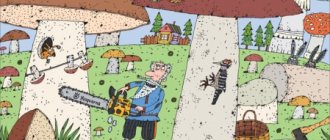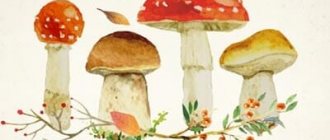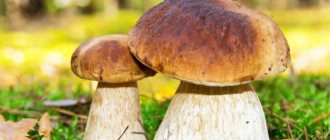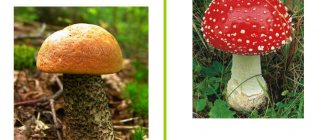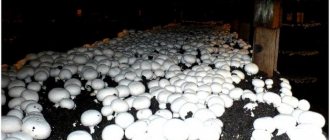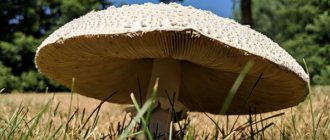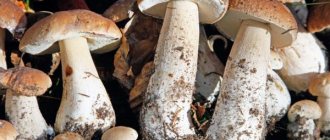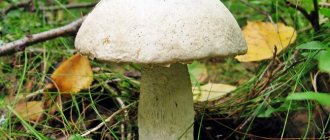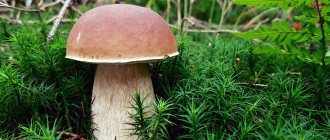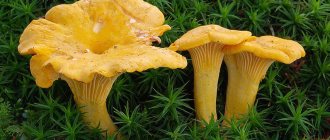- Reports and messages
- Mushrooms
- Chanterelle mushroom
The Latin name of the mushroom is Cantharellus.
They belong to the basidiomycetes, class Agaricomycetes, family Chanterelles, vidi chanterelles. The mushroom got its name for its red color, similar to the color of a fox. It is found in mixed and coniferous forests. But he especially loves birch and oak groves. It gets along well next to beech, spruce and pine. This mushroom loves acidic soils and often hides in grass or moss. Chanterelle is quite widespread in temperate forests and has been known to mushroom pickers since ancient times. This mushroom is collected from the end of May to the end of September. If the weather stays warm, the fox season will continue into October. The chanterelle grows in large groups, with peak growth occurring after a thunderstorm.
A distinctive feature of the chanterelle is its bright orange color. In height it is rarely higher than 15 centimeters. The shape of the mushroom is also unique. The stem smoothly transitions into the cap, without distinguishing it as a separate part. It is denser than the mushroom cap and its color is slightly lighter. The taste of chanterelle is slightly sour with a pronounced smell of dried fruit. The mushroom cap has an irregular concave shape with a diameter of 1.5 to 9.5 centimeters. The hymenophore (the reverse side of the cap) has a folded appearance with deep cells.
The chanterelle has several varieties, which are characterized by different territorial affiliations. The common chanterelle (true) is the most common. The gray chanterelle is the most rarely found species. Grows in central Russia, Ukraine, Western Europe and America. The vermilion chanterelle grows in eastern North America. The velvety chanterelle is common in the countries of southern and eastern Europe.
One of the advantages of chanterelle is that the pulp of the mushroom contains the substance quinomannose. This component protects the chanterelle from the effects of parasitic worms and their larvae. Quinomannose kills the eggs of helminths and other insects. It is for this quality that the chanterelle is valued among chefs from different countries; it is practically one of the purest mushrooms.
Chanterelle is an edible mushroom. It does not lose its taste properties in any type of preparation. Excellent transportability and storage. Due to the absence of worms, the chanterelle must be dried. Even in this form, its smell is not lost and its sour taste is preserved. During the cooking process, this aftertaste disappears and a pronounced mushroom aftertaste remains.
Chanterelle mushroom is contraindicated for children under 5 years of age, people with diseases of the gastrointestinal tract and with individual intolerance.
2nd, 3rd, 5th grade. In biology, the world around us
Interesting facts about chanterelles
Here are some interesting facts about chanterelle mushrooms:
- in the forest they grow in the form of “Witch’s rings”;
- the chemical composition contains a substance that kills Koch's bacillus (the causative agent of tuberculosis);
- Chanterelles contain more vitamin A than carrots and many other ingredients;
- at high temperatures, a large number of vitamins are destroyed - this applies not only to chanterelles, but also to most other products;
- Every year in the USA there are competitions to find the most original dish using this ingredient;
- The largest chanterelles are registered in California, where the weight of these mushrooms can reach half a kilogram.
In which forest do chanterelles grow and when to collect them?
Mushroom pickers often wonder where chanterelles grow because they don’t know where to look for them. They usually grow in large groups in mixed and coniferous forests of the temperate zone. But when exactly and how quickly do mushrooms grow? Chanterelles usually appear in June (or May if the spring is warm). However, then there is a large decline in numbers. But in August-October, a new peak in the growth of these mushrooms can be observed, and it significantly exceeds the period of early summer.
In which forest do chanterelles grow and when to collect them?
Common chanterelle
This block will be completely devoted to the common chanterelle mushroom. Most often people are interested in why chanterelle mushrooms are called that. The fact is that they are painted in a bright red color, which is characteristic of animals such as foxes. And thanks to the color similarity, the mushrooms were called chanterelles. This name has long taken root, and almost every person has heard about it at least once. Now let’s take a closer look at the common chanterelle from all sides.
Description
A genus of basidiomycete fungi. It is the type genus of the Chanterelle family. This is exactly how this representative of the fungal kingdom is classified in biology. It has another name - Cantarellus yellow, but this is how chanterelles are most often called by people close to science. Chanterelles are not fastidious mushrooms, that is, they can grow in May and in any month of summer-autumn (except November). At the same time, neither rain nor heat will disturb them. This explains the wide distribution of these mushrooms.
Fruiting places, harvest time
As mentioned above, chanterelles grow in coniferous and mixed forests. At the same time, they can be found both near trees and in clearings. They can be collected from May to October, but the peak occurs in the last 2-3 months. It is important to note that these mushrooms almost never grow alone. Therefore, after finding one chanterelle, you should look for others nearby. Usually people take away several baskets from one mushroom clearing.
Places of fruiting, time of collection of chanterelles
Taste qualities of chanterelles
Chanterelles have one of the best taste qualities among all edible representatives of the mushroom kingdom. They can be prepared in all ways: stewed, fried, boiled, salted, pickled, and so on. And all the same, the mushrooms will turn out very tasty. And in combination with their unusual and attractive appearance, children will definitely like chanterelles. True, it is worth giving them as food only after 8-10 years.
Something about quinomannosis
Hinomannose is a substance found in chanterelles that has excellent anthelmintic properties. That is, it destroys parasites and their eggs. Whereas most other antiparasitic substances affect only sexually mature individuals. Therefore, chanterelles are recommended to be used to cleanse the body of parasites and helminths. Hinomannose persists even after heat treatment, although not in such large quantities as in fresh mushrooms.
Popular topics today
- Fatigue
Human life is driven by energy. Each person's energy reserve is individual. Some people are born very energetic, while others barely have enough vitality to do the most ordinary things. But even the most - The image of Pushkin in the fine arts
Alexander Sergeevich Pushkin is a symbol not only of the “Golden Age” of Russian poetry, but is erected on the pedestal of the great creator of Russian literature of the ages. - Aquarius Constellation
This report describes basic facts about the Aquarius constellation, including size, celestial position, and history. - Scorpion
Scorpion is a terrestrial insect belonging to the order of arthropods. Outwardly it looks quite menacing. It lives in areas with a hot climate (mainly in arid zones). - Dream-grass
As soon as the sun's rays melt the snow after a long winter, at the edge of the forest you can find the first spring flower of blue-purple color with fluffy buds. People call it snowdrop - Cats
These cute animals belong to the genus of mammals, the cat family, which has existed on earth for 10 thousand years. Man domesticated the cat more than 6,000 years ago.
Chanterelles beneficial properties and contraindications
Do you know at what age you can give mushrooms to children? They can be eaten from 8-10 years of age, as they are poorly absorbed by the body. Another contraindication may be allergies and individual intolerances, bearing and feeding a child (if you are wondering whether pregnant women can eat mushrooms), as well as problems with the gastrointestinal tract. Eating mushrooms at night can also be considered contraindications - it is better to eat them 3-4 hours before bedtime. This way, chanterelles are better absorbed by the human body. Now let's talk about the benefits of mushrooms.
Medicinal properties of chanterelles
The chemical elements contained in chanterelles provide the following beneficial properties:
- an excellent remedy against parasites, thanks to quinomannose (by the way, because of it, worms do not eat the mushroom, so if you are wondering whether chanterelles are wormy, then worms are never found in them);
- preventive agent for cancer;
- vision regeneration;
- weight loss, as they have low calorie content;
- they make a good natural antibiotic, with which you can successfully fight bacteria;
- helps restore the liver due to its ergosterol content.
Medicinal properties of chanterelles
Video - healing chanterelles
We recommend watching the video: “Healing chanterelles - interesting facts.” The author talks in detail and interestingly about these mushrooms. Enjoy watching.
Places of growth
How long does the chanterelle mushroom grow? This process usually takes about one week. However, after heavy rain, the mushroom grows in a couple of days, maybe a little longer. Varieties of chanterelles grow in different places: some on swampy soil, others in clearings, others only near trees. But they all grow in the temperate zone next to coniferous or mixed forests. Therefore, you need to look for them in this area.
Where do chanterelles grow?
If you live in the Moscow region, then you can find out where chanterelles grow on this map.
Where do chanterelles grow?
Chanterelle collection season
Now you know where to find as many mushrooms as your family needs. But when exactly to go collect. We have already said that the peak occurs in August and September. In order not to miscalculate the timing of your trip for chanterelles, you should know a couple of rules. Firstly, mushrooms grow more actively after heavy rain. Therefore, after a rainstorm, it is recommended to go to the forest. Secondly, you can go every 1-2 weeks - during this time new chanterelles will grow.
How to collect chanterelles correctly
In order for a large number of chanterelles to grow in the same place every year, it is important to collect them correctly. If you do this incorrectly, the mycelium will be damaged. This means that mushrooms will not grow here in the future. Chanterelles must be carefully cut using a sharp knife. Under no circumstances should they be pulled out, kicked or twisted. If you don't care about other people, then at least care about yourself. It is unlikely that you want to destroy the clearing where you collect mushrooms.
Edibility of chanterelles
Chanterelles, whose calorie content is very small - only 19 kcal per 100 grams, are often recommended as a low-calorie dietary dish. You can prepare any dish from this edible mushroom – we will even look at some of them at the end of the article. However, there are inedible mushrooms, they are called false chanterelles. This mushroom looks similar to an ordinary chanterelle, but it cannot be eaten. Let's talk about them.
Edibility of chanterelles
Edible and inedible chanterelle: what is the difference
What mushrooms are called false? These are those representatives of the mushroom kingdom that look similar to edible mushrooms, for example, chanterelles, but are poisonous. These include talkers, hedgehogs and omphalotes - their photos and descriptions will be in the article. Here I would like to note poisoned edible mushrooms, which also cannot be collected. These include all types of chanterelles that grow near factories, highways and cities. Picking mushrooms near these places is strictly prohibited.
Popular methods of preparing the delicacy we are considering
Description of the poddubnik mushroom and its characteristics
As we found out earlier, chanterelles cannot boast of a long shelf life. Based on this, it follows that the product must be cooked or heat-treated within the first 24 hours after harvest.
We present to your attention the most popular ways to increase the shelf life of a product.
Cooking
It is believed that it is best to pre-boil any mushroom, and only then fry, salt, marinate or add to any dishes. This rule primarily applies to chanterelles, since it is after treatment with boiling water that the fruiting bodies of the plant lose their bitterness. If you want to cook chanterelles for dinner or stock up on them for future use, boil them on the stove or using a slow cooker, and then use them according to the previously planned “scenario”.
Frying
You can fry chanterelle mushrooms either raw or boiled. Cut the fruits into equal pieces and safely place them in a hot frying pan with oil. You will notice how first all the juice from the product will evaporate, and then the mushrooms will begin to fry and emit a pleasant aroma. The optimal preparation time for the treat is 30-40 minutes. Ideal additional ingredients are onions, pepper, salt, dill and sour cream.
Drying
If you decide to dry the harvested crop, it is important that it does not come into contact with water. Clean the fruits with a napkin or damp cloth, then hang the “mushroom beads” in a warm room or place the delicacy in the oven (you can use a special dryer)
Check the condition of the product every hour; if you overcook the chanterelles, the raw materials will literally begin to crumble in your hands, and will also lose a significant part of the useful elements.
Pickled
Chanterelles can also be pickled by wrapping them in sterile jars. There are a huge variety of pickling recipes, because each housewife optimizes the “sequence” of actions and ingredients to suit her own individual preferences. If we talk about the classic pickling recipe, mushrooms are boiled in salted water with the addition of citric acid, after which they are placed in jars and filled with liquid with vinegar, salt and seasonings.
It is very important to re-sterilize already filled jars, this will eliminate the risk of the snack spoiling or becoming moldy.
The product can be salted
Such preparation will not take much time; you just need to mix boiled or soaked fruit bodies with a few grams of lemon juice and plenty of salt. Garlic, onions, peppers, currants, dill or cloves can be added as desired. The appetizer is placed under pressure and aged for 48 hours, after which the dish can be served on the table or rolled into jars.
Some housewives prefer to ferment chanterelles for the winter.
This method of cooking has few fans, but they all exist:
- Clean the mushrooms from debris and rinse under running water.
- Cut the fruits into equal parts.
- Prepare a solution of water, salt and citric acid, boil the liquid.
- Add chanterelles, simmer for 15-20 minutes.
- Place the product in a colander, rinse, and wait for excess moisture to drain.
- Prepare the solution again: 2 liters of water + 10 tablespoons of salt + 4 tablespoons of sugar + 40 grams of fermented whey. Boil it. Adjust to 35-40 degrees.
- Distribute the mushrooms into pre-sterilized jars and fill with the solution. Cork it.
The dish will be ready in three days. As for freezing cockerels, you can send them into the cold boiled, fried or raw. The optimal storage container is food containers or plastic bags. Shelf life – 8-10 months.
We looked at how to recognize, process, cook and store chanterelles, and also studied how the forest product is useful. When going outdoors to hunt for prey, remember that gathering requires attentiveness and at least minimal knowledge about the culture for which the “hunt” is planned.
Characteristic
Despite the wide variety of chanterelle species, all these mushrooms are very similar to each other. Therefore, you can see what the common chanterelle mushroom looks like, and you will have a good orientation. Although beginners on their first trip are still recommended to take an experienced mushroom picker with them. This will be much more interesting, more educational, and safer. It is advisable to take at least a photo of the fox with you for clarity.
Characteristics of the common chanterelle
Characteristics of the common chanterelle
Let's take a closer look at what the chanterelle mushroom and its component parts look like.
Mushroom dimensions
The mushroom is quite small: the diameter of the cap rarely exceeds 10 cm, the height of the stem is between 4–6 cm, and its thickness is 1–3 cm. Depending on the species, they differ quite significantly. The largest specimens grow in the cockerel, the smallest in the tubular one.
hat
In young mushrooms, the upper part is slightly convex, but with age it becomes concave and funnel-shaped. The edges are sinuous and wavy. The spore-bearing layer is lamellar, passing onto the stalk. The gills are sparse, 1 cm less than 10. Some of the plates grow as if from nowhere and end “nowhere,” that is, they are not attached to either the cap or the leg. The color of the surface part ranges from pale yellow to golden-red in the common chanterelle. And from cream to light brown in the tubular one. The film is sticky and does not separate from the cap.
Pulp
The fruiting body of chanterelles is dense and white. The ordinary one has fibrous and fleshy pulp. It turns slightly red when pressed. The aroma of fresh mushrooms is fruity, and the taste is slightly sour.
Leg
In most species, the stem is hollow or tubular and slightly paler than the cap. The length depends on the diameter of the cap - they are approximately the same. The thickness is usually from 0.5 to 4 cm.
How long can chanterelles be stored fresh?
How long can chanterelles be stored fresh?
Once collected in the forest, chanterelles can be stored for up to 12 hours, after which they begin to deteriorate. Of course, you can put it in the refrigerator. Then the shelf life can be extended to 24 hours, but no more. Therefore, after returning home from a mushroom trip, you should immediately begin cleaning the chanterelles and preparing them for further cooking. You can prepare them in a variety of ways: boil, fry or prepare them for the winter.
Some tips for storing chanterelles
If you decide to freeze mushrooms for the winter, then they should be stored in the freezer in special bags or plastic containers. If you decide to pickle or marinate for the cold season, then in this case the chanterelles should be stored in sterile jars in the refrigerator or basement. If you do not follow storage rules, mushrooms stored for the winter will spoil during the first months. This means you won’t be able to enjoy summer mushrooms in the cold.
How to freeze chanterelles for the winter?
Before freezing, mushrooms should be thoroughly washed and dried well, laid out on a cloth.
You can freeze fresh, boiled, baked and fried chanterelles. Fresh (raw) mushrooms may taste bitter after defrosting. Therefore, before freezing, it is better to boil them in water or milk, fry them in hard butter or bake them in the oven. Prepared and dried mushrooms can be placed in freezer bags, food containers made of polymers, metal or glass, in the latter case filling the containers 90%. Close tightly so that the food does not come into contact with air. Store in the freezer at -18°C for one year.
Mushrooms should be defrosted on the bottom shelf of the refrigerator at a temperature of +4°C. To defrost, do not heat them or pour boiling water over them. In addition, thawed mushrooms cannot be re-frozen. If they accidentally thawed due to a refrigerator breakdown and you want to freeze them again, you can do this by first boiling or frying the mushrooms.
The use of chanterelles in cooking and medicine
As mentioned above, chanterelles have a pleasant, delicate and aromatic taste. Children especially adore them. And adults are not averse to enjoying mushroom dishes. They can be salted, boiled, pickled, fried, baked, stewed, and so on. The number of dishes that can be prepared with this ingredient is simply crazy. There is even a separate article dedicated to this topic on our website – I recommend you read it.
The use of chanterelles in cooking and medicine
Calorie content of chanterelles
The calorie content of chanterelles is 19 kcal per 100 grams, if we talk about fresh mushrooms. Whereas when cooked in any way, the energy value of mushrooms will only increase. Growth will depend on the cooking method. For example, boiled chanterelles have a calorie content of 25 kcal per 100 grams, but fried in oil already 69 kcal per 100 grams. Also, the number of calories depends on the ingredients used in the dish.
Application of plant fruiting bodies
Let’s pay a little attention to the areas of life activity in which chanterelles are used.
First of all, it's cooking.
As we noted earlier, the mushrooms we are considering are incredibly aromatic and pleasant to the taste. Experienced housewives and good cooks have become adept at boiling, frying, salting, pickling and even drying the delicacy. In addition to independent dishes, chanterelles harmonize perfectly in salads, sauces, soups and baked goods. The ideal simple side dish for the product is potatoes, rice, pasta or buckwheat. As for seasonings and spices for piquancy, the taste of chanterelles is even brighter if you add pepper, bay leaf, dill, celery or clove inflorescences to them.
Chanterelles in medicine
Traditional healers, healers and representatives of traditional pharmaceuticals are firmly convinced that chanterelles bring great benefits to the human body. Tinctures, extracts, tablets, and ointments are made from the fruiting bodies of the plant. Such remedies are useful for deteriorating vision, fungal or other skin lesions, infection with worms, as well as for diseases of the liver and respiratory tract. As for more severe ailments, the plant is useful in combination with other medications in the treatment of sarcoma, tuberculosis, and tumors. Are you sick with ARVI or tonsillitis? Mushrooms will help you get back on your feet much faster.
Fighting obesity or slight excess weight
Like any other mushrooms, chanterelles perfectly satisfy the feeling of hunger, and you only need to eat 100-150 grams of them. Due to its low calorie content, the product will not be “deposited” in the body, which means it will not add centimeters to the sides. People who practice weight loss diets know very well that mushrooms can replace high-calorie meat - it is enough to consume the product two to three times a week so that the body receives the required amount of nutrients and minerals. If the diet is “associated” with medical recommendations (for example, in case of digestive problems), it is best to give preference to boiled or stewed fruiting bodies. In just a few months of using such a “menu” you can get rid of 3-7 unwanted kilograms (individually, since everyone’s metabolism is different).
Chanterelles in cosmetology
In addition to traditional medicine, the fruits of the culture we are considering are in demand in cosmetology. For example, dried, powdered chanterelles are an important ingredient in anti-aging, moisturizing, and toning creams/ointments. Extracts or alcohol tinctures based on forest gifts are also effective in skin care. The nutrient can be purchased at a pharmacy or prepared independently; the Internet contains a large number of corresponding recipes.
Of course, for each of the described “cases” you need a certain, useful variety of chanterelles. That is why next we will look at the most famous edible chanterelles from more than 60 representatives of the family.
Types of chanterelles
Only a few types of chanterelles can be grown. However, under natural conditions, the diversity of these fungi generates - about 10 species of this representative of the fungal kingdom are found in nature. All varieties listed in this article are permitted for collection. But so that you can distinguish them, I suggest taking a closer look at what they look like. I identify mushrooms based on experience. You should study and it is advisable to take with you images of chanterelles.
Common chanterelle
Common Chanterelle
The type representative of the genus is the common Chanterelle. This is an edible mushroom in which the stem is fused with the cap. It has an orange tint, which can change to egg, yellow, etc. Sometimes the color fades to almost white. The shape of the cap changes depending on maturity. At first it is slightly convex, then gradually takes on the shape of a funnel, most often irregular. The cap grows up to 10 cm, on average about 5 cm. The consistency is fleshy and smooth. The edges are wavy and uneven.
The leg does not differ in color. It is dense, smooth, thin at the bottom and thickens towards the top. The average height is about 6 cm, thickness is no more than 3 cm. The flesh is also dense, yellow or orange. It is characterized by a slightly pungent taste and fruity smell. The hymenophore is folded in the form of false plates. They are thick, not densely spaced, from the cap they go straight down to the stem and smoothly pass into it. The spores are yellow.
Cinnabar red chanterelle
Cinnabar Red Chanterelle
The vibrant cinnabar red chanterelle stands out in its rich red-orange color. These mushrooms are small: the cap is no more than 4 cm, the stem is also up to 4 cm in height. The shape of the cap is convex at first, then becomes flat or slightly concave. The pseudoplates are thick, the same color as the fruiting body. Chanterelle grows near oak trees in summer and autumn.
Velvety Chanterelle
Velvety Chanterelle
The Velvety Chanterelle is a rare representative that grows in the deciduous forests of the south-eastern part of Europe. The cap is about 4 cm, can be convex or funnel-shaped. Shade – red-orange or bright yellow. The edges are wavy. The leg is small, thin, yellow. The pulp may be orange, yellow, or white.
Gray chanterelle
Gray chanterelle
The gray chanterelle or funnel funnel is considered a conditionally edible mushroom that has almost no taste. The cap is curved, funnel-shaped, and has a gray-brown tint. The folds on the inside are usually lighter. The leg is small, thin, ashy in color. The mushroom usually grows in groups.
Faceted chanterelle
Faceted chanterelle
Faceted chanterelle is an edible species. Usually grows near oak trees in groups. A characteristic feature of the species is an even more wavy, uneven cap, its edges hanging down. The dimensions of the fruiting body are from 2 to 10 cm. The color is bright yellow or orange. The folds are sparsely spaced or absent. Fruits all summer and until autumn.
Appearance and features
Among the moss and grass, chanterelles stand out for their bright colors. The color can be light yellow or dark orange, like the animal whose name they are named after. They are difficult to confuse with other mushrooms. In addition to the original color, they also have a unique shape. The hat does not have a clearly defined contour and separation from the stem - they form one whole. The edges of the cap are wavy and sometimes curled up. It can be flat with a concave middle, or it can be funnel-shaped.
Red foxes in a forest clearing. Photo: flickr.com/sandracohenrose
These forest creatures grow in groups. Children love collecting them because searching does not require special attention or eye strain. The color immediately reveals the place where the fungus is hidden, and it goes into the basket. The height of each individual can be from 4 to 7 cm, and the diameter from 3 to 8 cm (average sizes).
The best time to collect begins in August and ends in mid-October. During this period they can be found in any forest belt.
Another distinctive quality is the absence of wormy fungi. Worms simply do not take root in this species due to the presence of a protective enzyme. This substance is harmless to humans, but harmful to pests.
False chanterelles
False ones are mushrooms that look like chanterelles, but are inedible representatives of the mushroom kingdom. The coloring of the chanterelle mushroom and the false mushroom are very similar, which is why beginners may not recognize them. But such an indirect sign as worminess (almost all poisonous mushrooms are not affected by worms and parasites) will not help. After all, chanterelles are also not affected by pests.
Cooked false chanterelles can ruin the entire dish, as their toxic substances will also affect edible mushrooms. At the same time, some representatives of false mushrooms are bitter, which is why the dish gets a strong bitter taste. And in this case, you will also have to drain all the cooked mushrooms, even if you have been collecting them for several hours. In order not to make your work useless, it is recommended to know what false chanterelles look like.
Orange talker or false fox
Orange talker or false chanterelle
Orange talker has a small convex cap, which becomes flatter with age. The surface is dry, velvety. Various shades of orange are possible. The plates are of a brighter shade. When you press on them, brown spots appear.
The leg is low, up to 1 cm in diameter. The color is the same as the cap or more saturated. The pulp is dense, and in mature mushrooms it becomes cotton-like. White spore powder. The smell is weak, the taste is unpleasant, almost unnoticeable.
False chanterelles grow from August to the end of October. The growing conditions are the same as for the edible mushroom. For a long time, the talker was considered poisonous. Now it is classified as a mildly poisonous or conditionally edible mushroom - there is no consensus. Experts advise refraining from eating it.
Yellow hedgehog
Yellow hedgehog
It is worth noting the yellow hedgehog. This mushroom is similar in appearance to a chanterelle, but even if there is confusion, nothing bad will happen. The blackberry is absolutely edible with excellent nutritional qualities. Unlike chanterelles, under the cap there are not plates, but small spike-like growths that easily break off. The taste is identical to chanterelles.
Omphalote olive
Omphalotus oleifera
Omphalotus oleifera is an inedible poisonous mushroom. Inexperienced mushroom pickers may confuse it with chanterelle, which can lead to poisoning. The hat changes shape depending on age. First convex, then flat or funnel-shaped. The edges are strongly curved inward. Color ranges from pale yellow to orange-brown.
The plates of Omphalotus oleifera can emit a faint glow at night. The leg is uneven and dense. It may be the same color as the cap or a little lighter. The pulp is fibrous, yellow. The smell of the mushroom is unpleasant, and there is almost no taste. Omphalotuses grow near deciduous trees, on olive stumps. The growth period is all summer and autumn.
Appearance of the mushroom
There is no conspicuous cap, which is a continuation of the stem. Its color has a fairly wide palette, from light yellow to dark orange. The size of the cap can reach 12 centimeters. The hat has a round shape with wrinkled brims, shaped like sea waves, slightly concave in the middle. The general appearance of the mushroom resembles a funnel. The leg is slightly denser, usually lighter than the cap. The thickness reaches three centimeters, length from four to seven. The flesh of the mushroom is massive, quite dense, yellower at the edges, and lighter in the middle. When you press on it, it starts to turn a little red. It smells quite unusual, it smells sour with a hint of dry fruits and roots. There are practically no worms or holes inside the chanterelle. It has a folded structure going down to the stem. The spores are mostly light yellow in color and resemble an ellipse in appearance.
The picking time for such mushrooms is June, August and October. They are located in dense groups. More than six dozen species of this mushroom are known, the most popular of which is, of course, the common chanterelle. They can grow in a wide variety of climate zones.
To summarize
Finally, I would like to discuss growing chanterelle mushrooms. This must be done in a specially equipped room where temperature, humidity, lighting, and so on will be regulated. First, you should buy soil with fertilizers, then mycelium, which should be grown according to the instructions. White chanterelle is often used for cultivation. She's the easiest to work with. But white chanterelles are the most common.
False chanterelles
Don't forget what false chanterelles look like, as this will save you and your family from poisoning. Remember that for children under 8-10 years of age, it is advisable to exclude all types of mushrooms. Also, you should not eat them during pregnancy and breastfeeding. On your first trip, be sure to take a mushroom picker and a text description or photo of the chanterelle with you. In the comments below the article you can ask all your questions. Have a nice trip!
